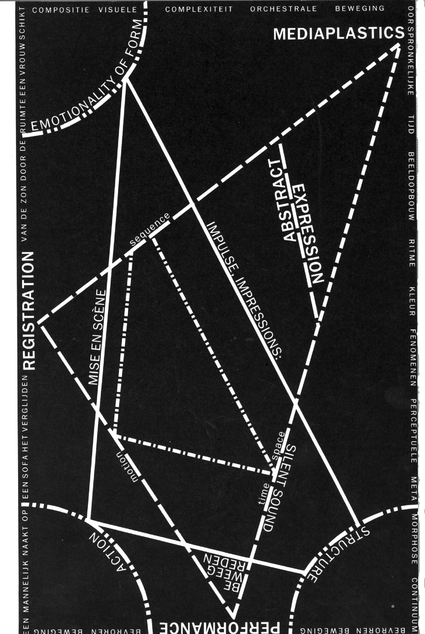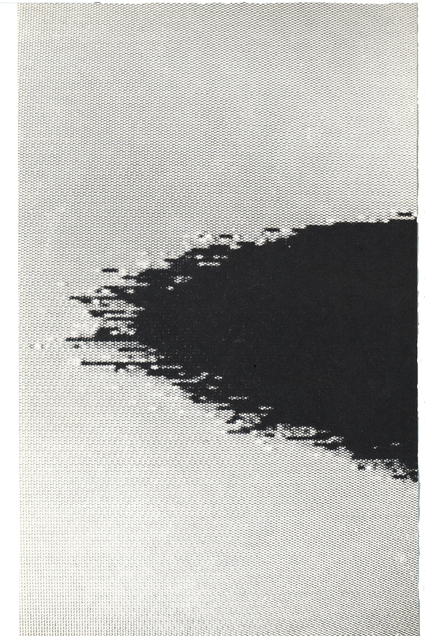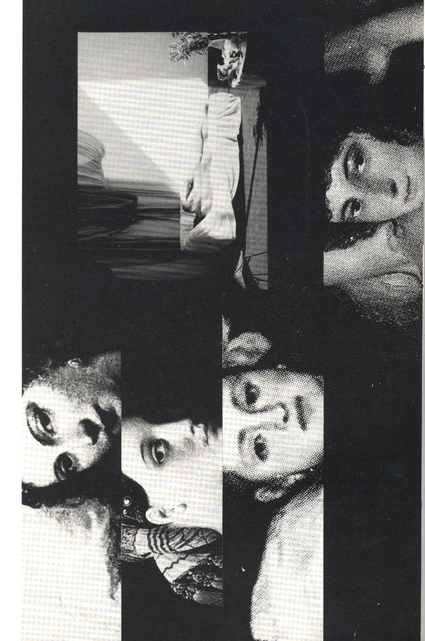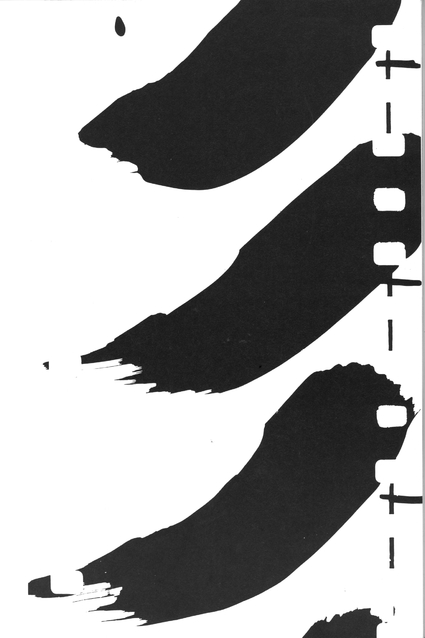The decision, which at first caused astonishment, fury and dismay, comes as the result of the DUTCH ART COUNSIL's advice (to the Minister of Culture) that there should be no more subsidies given to those organizations involved with video art, that is: all except one. So far as production facilities are concerned: in the future, subsidies will only be granted to individual artists and one central organization will be responsible for the presentation, distribution and documentation of their work. The organization chosen (after careful evaluation and comparison) is TIME BASED ARTS in Amsterdam.
TBA is doing its best to meet with the ministry's demands and has meanwhile been doing its homework: a 31 page policy outline which one hopes answers all the authority's questions and still adds something of its own.
For TBA's AART VAN BARNEVELD and his colleagues, it represented the firs step to the absolute power forced on them by WVC (The Ministry of Culture). We were a little shocked by these developments. WVC 's decision was lying on my desk when I came back from holiday. The ministry has arranged the whole business without the slightest consideration for the organizations. Such a radical decision destroys the whole structure which has been built up over the years. It means that the other organizations will have real problems; they've invested so much and now it's all gone.
Although VAN BARNEVELD disagreed with the way in which the decision was reached, he agreed with its general drift: Of course we're happy that we're the one.
One of the ART COUNSIL's strongest demands was that TBA should sever its traditional link with the ASSOCIATION FOR VIDEO ARTISTS . Despite the fact that in the new plan one seat on the Board of Management is reserved for the Association, VAN BARNEVELD expects there to be problems with the Association: The influence of artists on the policy of an organization like TBA is essential and must be guaranteed. Artists have very little say in the WVC's plan and the members of the Video Association are resisting it. However, the Video Association doesn't funcrion as it should and things have to be changed there too. It's too 'clubby' at the moment. My ideal would be a broadly-based association, a bit like the Dutch Artists' Union (the BBK) but representing the whole area of video and with strong links, in terms of policy and content, with TBA. In this form, the Association must have some say in the division of subsidies amongst individual artists.
For the rest, VAN BARNEVELD thinks that it's mainly a matter of continuing the broadening TBA's existing activities. He reckons that We're not going to get that big.
As it functions at the moment, there is too little theory within the video circuit: We've been having presentations without the thinking to go with it for long enough now. We want to change all that. The 'new' TBA wants to give people from outside, artists, critics and art historians the opportunity to contribute to the formation of theory. Thus, it will lead to 'a grammar and idiom' with which new developments in media art can be adequately described.
TBA must become an organization with a mediating function, one which remains open for outside influences. VAN BARNEVELD thinks that this also holds good for the resetting-up of a presentation circuit; to do that now the national government is no longer a funding body, we must apply in cooperation with local initiatives to the regional governments.
TBA hopes to view its task from a broad perspective, says its present director, and to develop into an art organization covering-the area of video, film and sound, a development which has already been set in motion. In its policy outline, along with its response to the government's demands, TBA attempts to underline the point concerning simple, inexpensive production facilities, which must remain available for experimentation by young artists in particular. It can be very practical like, for instance, at STAMPIJ where you can work at inexpensive rates. Although the Arts Council emphatically advised that no production organization should be subsidized anymore (MEATBALL and MONTEVIDEO are the victims of this policy), VAN BARNEVELD feels that there is still room for talks with the Ministry of Culture if you can show that it's important.
Such benevolence comes too late for the previously well financed MONTEVIDEO. The organization is in a state of collapse after the internal discussions about what should happen after the withdrawal of funding. Founder RENé COELHO opted for 'back to square one' and retreated to the Singel, with no members of staff. That's how we began, as a small video gallery. I find it very attractive in itself; also, mainly due to the government policy, we became a bit too big. Now, I really want to have a sort of gallery showing the 'first devision of Dutch video art'. My preference is closely linked with visual art and with innovative aspects, the relationship between image and sound, new technology but always in terms of visual art and less to do with the media. Although it's called media art, in my terms, technology is not predominant. Along with the gallery, COELHO hopes to maintain the production facilities. We want to try to let the artists use the equipment as much as. possible at inexpensive prices that are much cheaper than in the commercial studios. Also we want to maintain our distribution, but without a subsidy because we're so tired of all that begging - and for all those years!
COELHO has little faith in the ministry's motives; They just want to get rid of that art form, they think it's too costly and uninteresting, so they've wrung the necks of the production places and the distribution facilities - that is, all except one because they - in my opinion at least - actually think that video should die a natural death. It's a terminal construction. 1 wonder how TEA will survive all this, I hope it will be OK. There was always friction between us but new-style MONTEVIDEO hopes that people from the new-style TBA will use our facilities as much as possible.
Looking back at the wealthy past, COELHO says, There were ten people working here in its heyday, all paid. Of course, it was a bit too much, but OK, If that's made possible you're going to do it, aren't you? One important task which we can't do anymore but grew like the proverbial beanstalk with us is the consideration of the artists' interests. We had full-time staff for that work whom we can't pay anymore.
At the time, that full-time staff was the MONTEVIDEO subsidy whizz-kid: NICO-that's how we deal with WVC-PAAPE. Along with colleague MAARTEN NOYONS, PAAPE had very different plans for MONTEVIDEO which, after a somewhat turbulent meeting of the Board of Management, finally lead to a schism.
We tried to introduce the board to other ways of thinking. The decision to do away with MONTEVIDEO in its old form is, in my opinion, not so much a rational as an emotional one. There were other possible alternatives. I find it very disappointing but I respect the board's decision and it's not as If we've split up like very angry kids; we're just pursuing our own interests.
For PAAPE and his group, those interests lie in the area of new technologies. Of course, the point of departure is still the fact that the media artist inspires the whole thing. But the image of the artist will change in the future. The borders between the different art disciplines will become blurred through the use of new technologies and interactive electronics. Whether you're working for visual artists, musicians, theatremakers or architects, the equipment and the software is more or-less the same but it's about what you connect it with.
PAAPE and NOYONS are aiming for a technological experimental space à la STEIM, 'a sort of creative think-tank' where, with support from companies such as PHILIPS and SONY, the artist will be able to survey the borders of technology. The talks about it are at a very advanced stage, says PAAPE self-confidently, we've said to those companies, as large-scale industries, put some effort into making a media art laboratory like at MIT. STEIM or SONOLOGY, but there's not that much enthusiasm because it's tremendously expensive. So we're aiming not so much to own equipment ourselves as to find facilities at SONY and PHILIPS, equipment we can borrow and suchlike. It's much easier; 'he who travels fast, travels light' - right?
The media art laboratory that PAAPE has in mind will be housed in MONTEVIDEO old premises in North Amsterdam. They've found a sponsor for next year's rent.
The other large subsidized organization, the KIJKHUIS in The Hague reacts somewhat laconically to the ƒ 165.000,- cut-back to their annual budget. It doesn't mean we're going to have to throw in the towel, says TOM VAN VLIET from the KIJKHUIS, we have the advantage of not being dependent on just one source of income; we also get money from The Hague's City Council and we also have our own income. We'll have to boost that. Of course it has radical consequences: up till now, we've been open five days and three evenings a week and that will stop. From January, visits will be by appointment only and when we have special programs. And that means redundancies.
The KIJKHUIS will still realize and show video performances, installations and tapes but less frequently than before. Also no-one's thinking of stopping organizing the successful annual video festival. In terms of distributing tapes (and the need to raise more income itself), the KIJKHUIS will actually intensify its activities. VAN VLIET (pugnaciously): We couldn't stop even If we wanted to because we've got contracts, appointments and people quite often approach us. We're involved with a number of international video concerns who have offered us the distribution of a number of tapes. We have here a distribution system that has been in existence for 8 years and which we're not going to close down because of what might be the ministry's short-lived decision. We don't have so much to do with WVC, besides they're talking about visual art whereas we've always been interested in the media whether or not it's art. And it can't have gone so far in this country that the state decides who can do what?
VAN VLIET hasn't got a good word to say about the ministerial decision to fund just one organization. It's a bad decision. Video in the Netherlands has its origins in all kinds of little clubs and that's its basis. And you see: all the artists find it an unwise decision as do the organizations. It removes the foundations. Of course you mustn't duplicate things but still you have more than just one gallery. They tried to centralize the film world and it's been a disaster. I think an artist must be free to choose which organization he wants to work with.
The ministery's measures are also tangible in the provinces: WILLEM VELTHOVEN and JANS POSSEL from the MEDIAMATIC FOUNDATION, which provides video art screenings in Groningen, are fed up of it. VELTHOVEN: look, if the financier, in this case WVC, says that what you're doing isn't worth bothering about then the question of whether you should continue comes into play. We'll be stopping the regular screenings from 1st January which we've been organizing for the past three-and-a-half years. Apart from the subsidy being stopped, it's due to the fact that we want to spend more time on the magazine.
Although VELTHOVEN also finds the WVC decision unwise, he's inclined not to predict any disastrous consequences; I don't know If it's such a bad thing. I wonder, if you look back in five years time, whether 1st January 1987 will be seen as the day when Dutch video art disappeared. I don't think it will be that serious. What I am curious about is how TIM will fulfill their new task. They'll think - and this is the consequence of being the only one - that they'll have to cover everything now. It means that it will be still more difficult for them to follow a policy with clear choices of art and content. It's bound to result in a less inspired kind of universality which they've also been more or less forced into by WVC. I've got my doubts. Perhaps it's much more meaningful to make choices about content, actually it's something all the organizations have been lacking up to now. Now, with no more money and all that misery we should think what it is that we really find important and save our energy. For us it's the magazine, for others it could be a particular group of artists. Seen from the perspective of video, in a way the WVC decision does make things clearer.
New initiatives are popping up in the margins of this regrouping. Sometimes 'reluctantly' as GEERT-JAN HOBIJN from STAALPLAAT, the avant-garde cassette shop, describes its resolve to distribute videotapes as well. STAALPLAAT is looking into the possibility of bringing out VHS tapes which don't fit into the art circuit, like the tapes form RESEARCH, an American group, English movements like the ROMANTIC AESTHETICS and some music videos that are really experimental.
STAALPLAAT plans to hire the tapes out to youth centers, discotheques and suchlike and speaks ideally of a system like the regular video farmer who hires out his tapes, preferably at the same prices. Bearing in mind the lack of capital needed to set up a VHS distribution system, people are looking to TBA for facilities and logistical support. 'The TBA big boys' are considering the proposal.
Another new initiative comes from Ex-MONTEVIDEO brats HARRY 'DEDO' HEYINK and KEES DE GROOT who have decided to set up an agency-cum-club. The club, the LOGE BETHANIëNIEN (BETHANIëNIEN LODGE) will be a meeting place for media artists with presentations of 'interdisciplinary, multi-media art' at set times. The work of the founders and a select group of other artists (including SLUIK & KURPERSHOEK) is being housed in LOGE 4D (4D LODGE) which also looks after the distribution. According to KEES DE GROOT, both 'loges' intend to go beyond video; we're also creating the underground, the marginal, we want more than just tapes and video installations, hence the emphasis on the interdisciplinary. The axis of LOGE 4D will be its agent, someone who combine business acumen with the insight of an history. The group around HEYINK and DE GROOT have applied to Amsterdam City Council for a starting subsidy, the agent will have to be paid out of money from the Ministry of Culture.
The ministry will be dealing with still more subsidy requests in the near future. After a period of re-orientation and reorganization, nearly all the organizations affected by the cuts are going 10 apply to the minister with fresh courage and stronger arguments; the Arts Council is busy once more and will have to notice that probably very little will come of the most important objective of its last advice to the Minister of Culture. New and old distributers and presenters are undermining in advance TBA's position as the umbrella organization for video art. Within the organizations, everyone is beavering away at the cultivated diversity which has lead to a complicated network of contracts and personal links between artists, organizations and public. Even AART VAN BARNEVELD acknowledges that there are real problems in growing towards the umbrella function that the government requires.
Perhaps the Arts Council has put its financial affairs in order but it has made a complete mistake about the social structure of the video scene.
If you'd like to quote something: Bruinsma, Max. "No Subsidy? No problem!" Mediamatic Magazine vol. 1 # 3 (1987).
Note of the translator: 1) This is a direct quotation from Servaas' letter to the Canadian magazine Video Guide 1986.
Translation: Annie Wright



